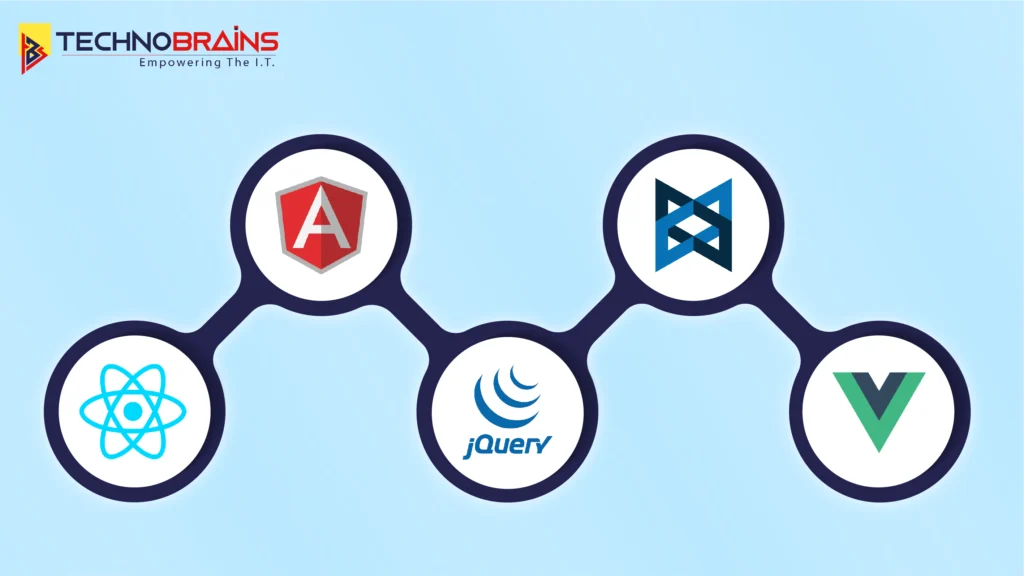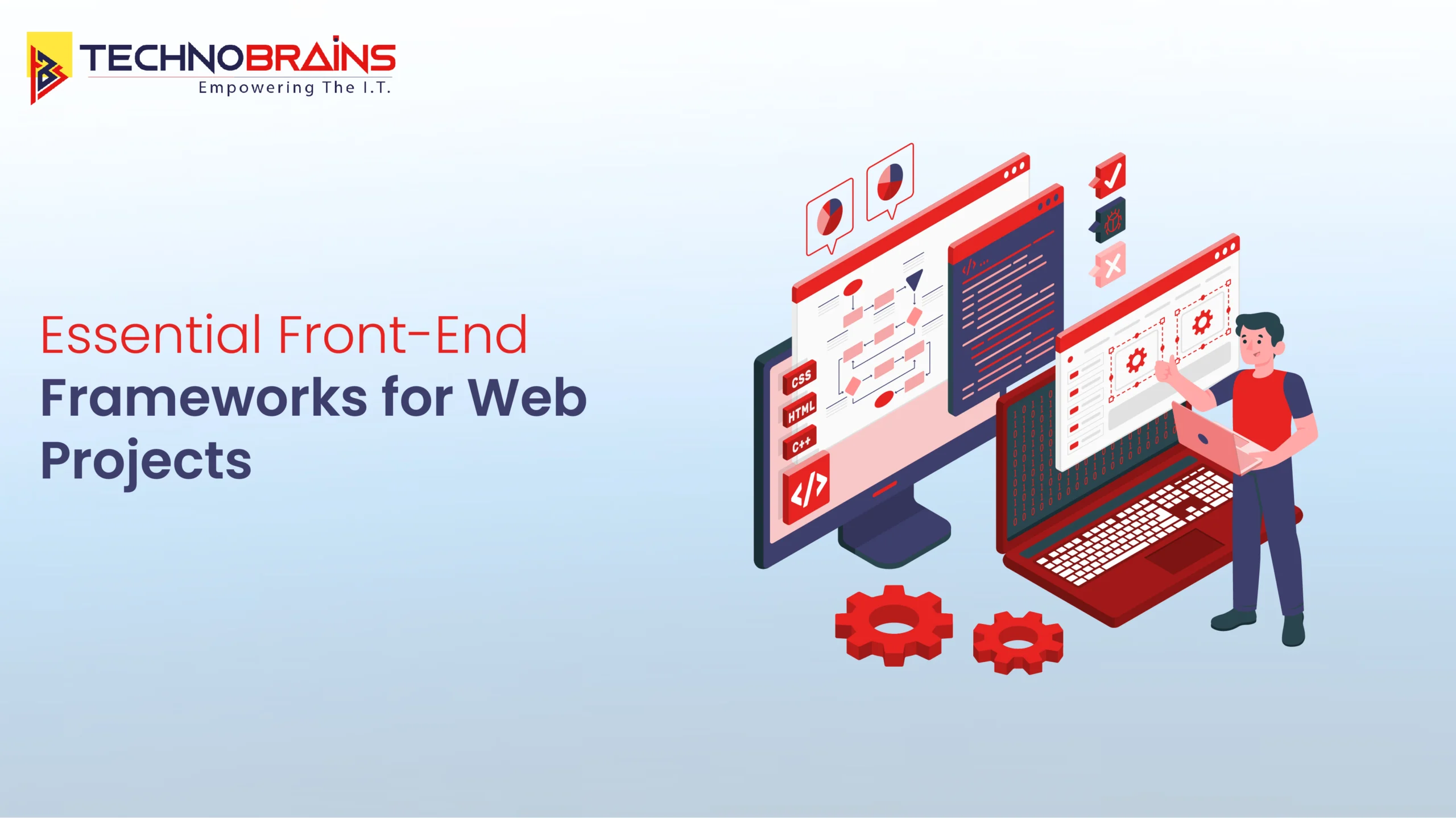The landscape of web development is vast and dynamic, with there being an “n” number of technologies and frameworks out there.
Each frontend framework consists of various features and functionalities that cater to modern development requirements. On the other hand, the sheer number of options can actually complicate the selection process, particularly in frontend development.
A well-selected frontend framework has the potential to build software solutions that captivate end-users and elevate a business’s success to new heights. During the development of front-ends, focusing on simplicity, visual appeal, responsiveness, and functionality is key. Ensuring these elements are in place can guarantee a pleasant and enjoyable experience for users. But again, it all boils down to the frontend web development framework you choose, making it a significant factor in your project’s success.
To help you streamline the decision and decide upon the best one, we’ll discuss the top frontend frameworks, exploring them in detail. Let us begin!
What is a Frontend Framework?
The front end of a website or web application is essentially the set of elements visible to a user, such as its layout, color schemes, graphics, typography, etc. An attractive, user-friendly front end enhances the user experience, engaging visitors and retaining them in the long run.
A frontend framework is a platform that equips developers with pre-built tools, libraries, and components to streamline building intuitive, flawless interfaces and front ends. Leveraging these resources, developers can craft engaging digital experiences.
Read Also, Hottest Web Development Trends for 2023: What to Expect
Best Frontend Frameworks for Web Development

Frontend frameworks are critical to elevating user experiences by meeting their needs for seamless, visually engaging, and highly interactive interfaces. With these frameworks, businesses can not only meet but surpass user expectations, driving enhanced engagement, increased satisfaction, and ultimately the initiative’s success.
As such, selecting the best frontend frameworks for web development is of utmost importance. Below is a list of the top frontend frameworks to assist you in making a decision:
- React
- Angular
- jQuery
- Backbone.js
- Vue.js
Next, we’ll delve into each framework individually.
1. React
React.js is the most popular frontend library, created and supported by Facebook, known for its speed, scalability, and simplicity. It is recognized as one of the top open-source frontend frameworks, with around 40.6% of software developers worldwide utilizing it.
Renowned corporations like PayPal, Netflix, Walmart, Tesla, and more leverage React for its features, emphasizing its dependability and excellence.
With React’s component-based architecture, developers can take advantage of reusable and encapsulated UI components to efficiently create more advanced user interfaces. This leads to improved code organization and time savings. React utilizes a Virtual DOM for effective UI rendering, adopts a declarative programming style, and offers features like one-way data binding, all contributing to its popularity in front-end development.
2. Angular
Angular is an open-source, frontend framework built on TypeScript that enables developers to create an extensive array of robust as well as feature-rich solutions. Google first unveiled AngularJS in 2010, which, after an in-depth modification, was released as Angular 2.0, now known as Angular.
Well-known global corporations, including Google, Microsoft, Upwork, BMW, and many more, favor employing Angular to fulfill their requirements.
Angular stands out due to its distinctive two-way data binding structure. This means that the model and view are synchronized in real-time. Consequently, any modifications made to the model will almost instantly be reflected in the view, and vice versa. This useful feature allows developers to readily observe exactly how changes they make to the application appear in real-time.
Developers can construct an extensive variety of software applications using Angular, including progressive web apps, single-page applications, and desktop and mobile apps. Angular is an all-encompassing platform that precisely fulfills the numerous demands of contemporary development due to its versatility.
Read Also, Top Benefits of Outsourcing Web Development
3. jQuery
jQuery is a prevalent JavaScript library released in 2006 that continues to be widely utilized by developers worldwide. Despite its antiquity, it remains user-friendly and simple to grasp; its intuitive structure entirely eliminates the need for lengthy and intricate JavaScript code.
Several reputable businesses use jQuery, such as Uber, Netflix, IBM, Google, and Twitter.
Developers no longer need to struggle with complex programming concepts or rely on additional libraries in order to construct elaborate user interface components because of the framework’s capabilities and versatility. jQuery improves the interactivity and usability of websites and applications by simplifying CSS and DOM manipulation, making user interactions smoother and more responsive.
4. Backbone.js
Backbone.js is a lightweight toolkit built using JavaScript in October 2010 that facilitates the swift and easy development of single-page applications. Requiring little setup, simple design, speed, and flexibility, Backbone.js is a well-liked front-end framework for developers.
Many prestigious businesses throughout the world, like Pinterest, Walmart, and Airbnb, make use of Backbone.js.
This framework can be easily integrated with other libraries and frameworks, permitting developers to take full advantage of its capabilities. It separates application logic and user interface, providing them with a way to create web-based software more efficiently.
5. Vue.js
Initially released in February 2014, Vue.js is a flexible and open-source JavaScript library. It can be used to build a broad range of applications, including mobile apps, basic websites, and intricate single-page applications.
Major companies such as Xiaomi, Upwork, Alibaba, and Nintendo use Vue.js for their projects.
Its small size, performance, component architecture, intuitive syntax, two-way data binding, and more make it an ideal choice for developers and businesses; its growing prominence can be attributed to these qualities. With these advantages, it’s no surprise that Vue.js is considered among the top frontend frameworks and earned a spot on our list.
Read Also, Freelancers vs Web Development Company : Which One to Select?
To Conclude
The frameworks described above are the top frontend frameworks for web development. Selecting an optimal framework for your web endeavors requires careful consideration and planning, whether it’s deciding upon the best backend frameworks or frontend ones. When combing through the myriad options, take into account factors like project specifications, team expertise, community support, and individual preferences. By weighing these variables, you’ll settle upon a framework that aligns with your goals and objectives, increasing your chances of success.
If you’re still perplexed or have any questions, consider contacting TechnoBrains. Being a leading-edge web development company, we can provide expert guidance and help you come to a well-informed decision on the subject matter.







